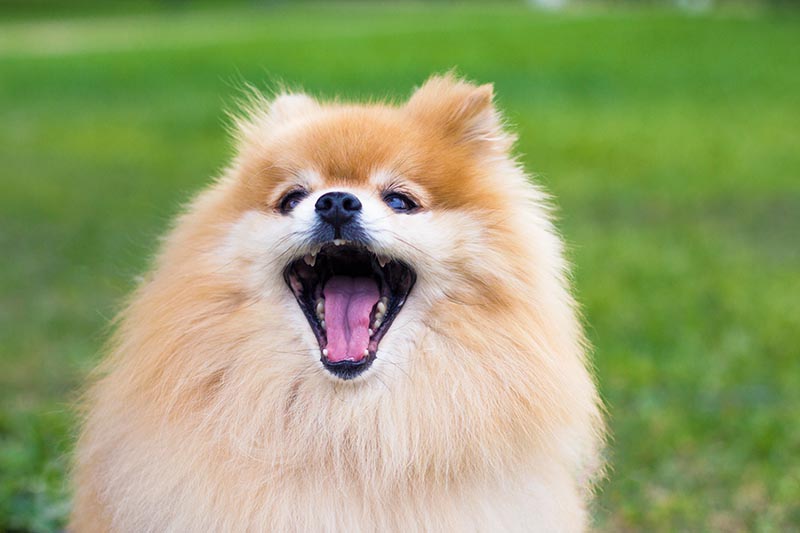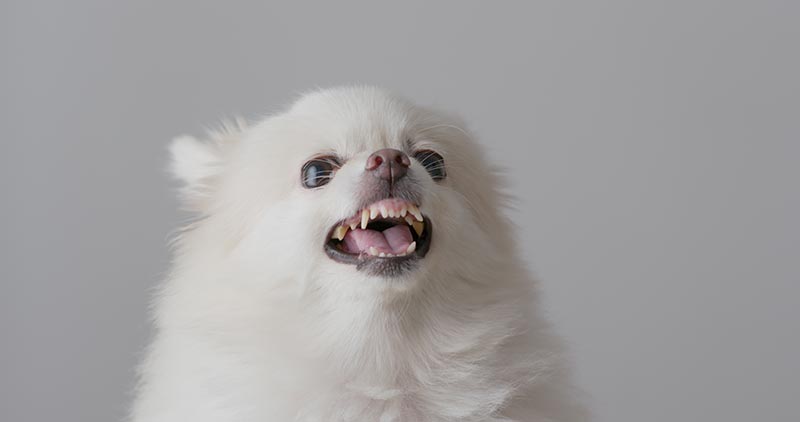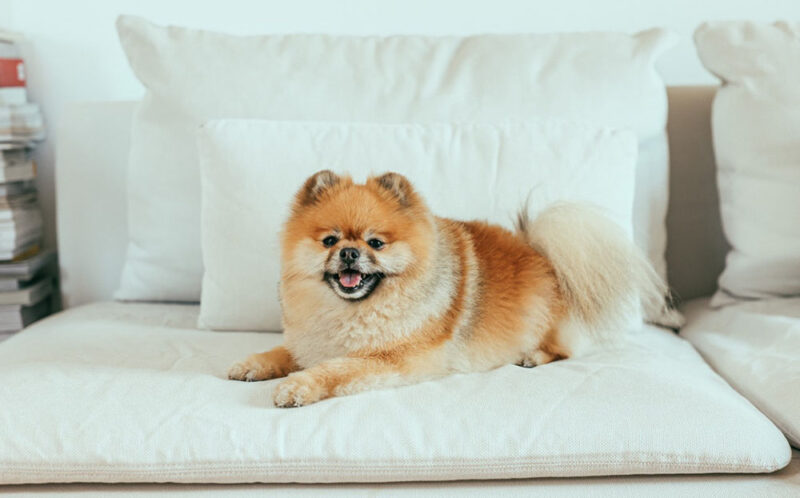Pomeranians are tiny, lively dogs full of energy and pizazz. They are among the smallest breeds and are often compared to teddy bears. But do they share the same temperament? As long as they are properly socialized as puppies, Pomeranians are not known to be aggressive.
It can be tricky to determine the aggression level of a dog breed, as each dog is an individual. It’s also important to note the distinction between true aggression and reactivity caused by different factors. In this article, we’ll look at these points, what the Pomeranian is really like, and what aggression might look like in the breed.

What Are Pomeranians Like?
The little Pomeranian is a proud and loud pup, boasting the personality traits of confidence, boldness, affection, and playfulness. While each Pom is different, many have big personalities that defy their size. They have a huge fan base because of their loyalty and friendly nature towards their families, plus they have gorgeous coats! But because they are brash, they can escalate to being overzealous and overly noisy.
A few traits commonly associated with Pomeranians could be seen as aggressive, although they are nearly always from a place of protection or excitement.
Barking
Barking is standard Pom behavior but is usually directed at strange dogs or people. This can be taken as aggressive, but it’s more akin to communication and over-stimulation.
Playing Rough
Playing is also something all dogs do, and even small dogs like the Pom can play a little too rough. “Roughhousing” can sometimes be misconstrued as aggression, but it’s just rough play. This behavior is particularly common in puppies, as it helps them to learn control and boundaries with other dogs and people.
Some Pomeranians may become reactive to other dogs or people due to certain life experiences or situations. For example, Pomeranians that are not taken for walks very often can experience anxiety and nervousness when faced with new dogs and people.


What Is Aggression?
True aggression is hostile, destructive, or injury-causing behavior towards another dog, animal, or human. This is quite specific, and many behaviors that can be seen as aggressive may not be.
Behavior such as biting, snapping, growling, and showing teeth are all associated with aggression and are often associated with fear. However, a Pom growling and lunging on a leash might be reacting to something rather than showing outright aggression, but the opposite could also be true. It can be complicated to figure out!
What Is Reactivity?
Reactivity is a behavior commonly confused with aggression and is defined as a heightened state of emotion due to a specific stimulus. For example, a Pomeranian may become nervous and agitated because it walks past a man in a hat. The man in the hat is the specific trigger for the behavior and is usually caused by a lack of desensitization or due to learned experiences.
In this example, the dog might have negative associations with men in hats, leading to an overreaction to seeing them. On a leash, the dog can’t run away, so it displays over-reactive behavior to try and protect itself.
Often, if reactive behavior is not remedied, dogs can escalate to become aggressive.


What Can Make a Pomeranian Aggressive?
Aggression is often caused by fear or resource guarding, which are very different. If a Pomeranian is fear aggressive, it will feel as though it has no choice but to fight in a “fight or flight” situation when it’s scared. A cornered dog will often turn to aggression when afraid as it cannot run, such as if a dog snaps at a person’s back when they begin to turn away.
Resource guarding is another source of aggression, which stems from a dog’s instinctual urge to defend and protect what is essential. Food, toys, and even people can be guarded, and Pomeranians can be more inclined to protect their family or prized possessions than other breeds.
Another reason for aggression in Pomeranians (and dogs in general), such as snarling and snapping, is pain. If you have a Pom that’s usually happy and carefree but suddenly acts aggressively if you pick them up or approach them, they might be in pain. It’s vital to take them to the veterinarian if this is the case, as pain can often change a dog’s personality.
What Does an Aggressive Pomeranian Look Like?
Pomeranians displaying aggression will show the same body language as other breeds. However, they are small dogs with more fur, so some expressions, such as raised hackles, can be more challenging to interpret.
Poms displaying aggression or are about to bite might:

What Does a Reactive Pomeranian Look Like?
Reactive Pomeranians are not yet aggressive, but the signs can be similar. Overexcitement and overstimulation are common causes of reactivity, and anxiety is often observed in reactive Poms. Signs of reactivity and overstimulation include:
Pomeranian owners need to recognize this body language in their dogs; ignoring a dog’s attempts to communicate anxiety or overstimulation can lead to aggression.

Happy Pomeranian Body Language
As much as it’s important to know when your Pom might be feeling overwhelmed or needs space, it’s also essential to be able to differentiate play and other positive body language from reactivity or aggression.
As we discovered before, dogs and puppies play rough to bond and learn. The same is true for Poms, and because they are so small, it can sometimes be more difficult to determine their body language when they’re on the move! Happy, playful, positive body language a Pomeranian might display can include:

What Should I Do if I Think My Pomeranian Is Aggressive?
If you have a Pomeranian exhibiting reactive or aggressive behaviors, the best thing to do is take them to the veterinarian for a check-up. The vet can perform a physical exam and a consultation about their behavior. They can check to see if your pup is in pain and might ask you about their home environment. They’ll likely then refer you to a trained dog behavior expert who can work with you on your Pom’s aggression.

Final Thoughts
Pomeranians are usually friendly dogs that love their family and generally get along with others. Some dogs may be aggressive, but that is true for any breed and comes down to the individual’s personality and experiences. Good socialization can prevent aggressive or reactive behaviors.
Enrolling a new Pomeranian puppy in obedience classes will socialize them and help them bond with you. If you have a Pom that’s aggressive or reactive, the advice of your veterinarian and a canine behaviorist can remedy it and improve the behavior.
Featured Image Credit: Maxim Shmakov, Shutterstock

